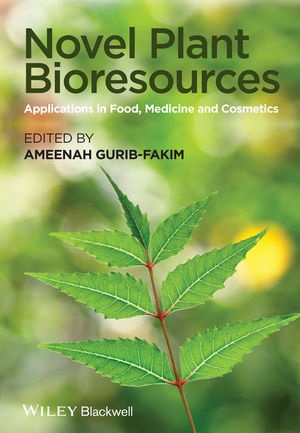Mehr lesen
Novel Plant Bioresources: Applications in Food, Medicine and Cosmetics serves as the definitive source of information on under-utilized plant species, and fills a key niche in our understanding of the relationship of human beings with under-utilized plants. By covering applications in food, medicine and cosmetics, the book has a broad appeal.
In a climate of growing awareness about the perils of biodiversity loss, the world is witnessing an unprecedented interest in novel plants, which are increasingly prized for their potential use in aromas, dyes, foods, medicines and cosmetics. This book highlights these plants and their uses. After an introductory section which sets the scene with an overview of the historical and legislative importance of under-utilized plants, the main four parts of the book are dedicated to the diverse potential application of novel plant bioresources in Food, Medicine, Ethnoveterinary Medicine and Cosmetics.
Examples and contributors are drawn from Africa, Europe, the USA and Asia. The economic, social, and cultural aspects of under-utilized plant species are addressed, and the book provides a much needed boost to the on-going effort to focus attention on under-utilized plant species and conservation initiatives. By focusing on novel plants and the agenda for sustainable utilization, Novel Plant Bioresources highlights key issues relevant to under-utilized plant genetic resources, and brings together international scholars on this important topic.
Inhaltsverzeichnis
List of contributors xiii
Foreword xvii
PART ONE NOVEL PLANT BIORESOURCES: APPLICATIONS IN MEDICINE, COSMETICS, ETC. 1
1 Plant Diversity in Addressing Food, Nutrition and Medicinal Needs 3
M.E. Dulloo, D. Hunter and D. Leaman
2 World Health Organization Perspective for Traditional Medicine 23
Ossy M. J. Kasilo and Jean-Baptiste Nikiema
3 Cultivation of Novel Medicinal Plant Products and Associated Challenges 43
Ulrich Feiter
4 Enabling Technologies to Facilitate Natural Product-Based Drug Discovery from African Biodiversity 57
Nyaradzo, T., L. Chigorimbo-Murefu, Grace Mugumbate and Kelly Chibale
5 Assessing Biodiversity: A Molecular Approach Using DNA Sequencing 69
Yasmina Jaufeerally-Fakim
6 Conservation of Endangered Wild Harvested Medicinal Plants: Use of DNA Barcoding 81
Sarina Veldman, Joseph Otieno, Barbara Gravendeel, Tinde van Andel and Hugo de Boer
7 Market Entry, Standards and Certification 89
Susan A. Wren
8 European Union Market Access Categories and Regulatory Requirements for Novel Natural Products 107
Thomas Brendler and L. Denzil Philipps
9 Nutrition, Health and Food Security: Evidence and Priority Actions 125
L. J. Ferrao and T. H. Fernandes
PART TWO MEDICINE (PLANTS AS MEDICINE: HUMANS AND ANIMAL HEALTH) 131
10 Anticancer Potential of African Plants: The Experience of the United States National Cancer Institute and National Institutes of Health 133
John A. Beutler, Gordon M. Cragg, Maurice Iwu, David J. Newman and Christopher Okunji
11 Biodiversity as a Source of Potent and Selective Inhibitors of Chikungunya Virus Replication 151
Pieter Leyssen, Jacqueline Smadja, Philippe Rasoanaivo, Ameenah Gurib-Fakim, Mohamad Fawzi Mahomoodally, Bruno Canard, Jean-Claude Guillemot, Marc Litaudon and Francoise Gueritte
12 Using African Plant Biodiversity to Combat Microbial Infections 163
J. N. Eloff and L. J. McGaw
13 Plant Medicines Used in the Treatment of Malaria 175
John R.S. Tabuti, Antonia Nyamukuru and Mohammed Lamorde
14 Multiple Anti-Infective Properties of Selected Plant Species from Zimbabwe 179
Rumbidzai Mangoyi, Tariro Chitemerere, Theresa Chimponda, Elaine Chirisa and Stanley Mukanganyama
15 Development of Phytodrugs from Indigenous Plants: The Mali Experience 191
Rokia Sanogo
16 Healing Aloes from the Mascarenes Islands 205
Joyce Govinden-Soulange
17 Pharmacological Activities of Some of the Neglected and Underutilized Tropical Plants in Malaysia 215
Z.A. Zakaria, F. Yahya, T. Balan, S.S. Mamat, R. Rodzi, F.H. Kamisan, C.A. Fatimah and A.L. Ibrahim
18 Multiple Applications of Endophytic Colletotrichum Species Occurring in Medicinal Plants 227
Mahendra Rai, Gauravi Agarkar and Dnyaneshwar Rathod
19 African Plants with Potential for Development into Ethnoveterinary Products 237
L.J. McGaw and J.N. Eloff
20 African Plant Biodiversity in Pest Management 263
S. N'Danikou, D.A. Tchokponhoue, C.A. Houdegbe and E.G. Achigan-Dako
21 Commercialization of Ethnoveterinary Botanical Products 285
David R. Katerere
22 Plants Used for Pest Management in Malawi 295
Cecilia Maliwichi-Nyirenda, Lucy Lynn Maliwichi and John F. Kamanula
PART THREE FOOD (SPICES, FRUIT AND VEGETABLES, ETC.) 303
23 Aromatic Plants: Use and Nutraceutical Properties 305
Lucia Guidi and Marco Landi
24 'Let Your Food Be Your Medicine': Exotic Fruits and Vegetables as Therapeutic Components for Obesity and Other Metabolic Syndromes 347
Mohamad Fawzi Mahomoodally
25 Strategic Repositioning African Indigenous Vegetables and Fruits with Nutrition, Economic and Climate Change Resilience Potential 361
M.O. Abukut
Über den Autor / die Autorin
Ameenah Gurib-Fakim is Professor and Managing Director at the Centre for Phytotherapy Research (CEPHYR) in Mauritius. She has authored several books on medicinal plants and on the flora of Mauritius and Africa and has received several international prizes. In 2013, she receives the Honorary Doctorate from the Universite Pierre Marie Curie (Sorbonne Universites) and is also Honorary Professor at UNISA, Pretoria, South Africa.
Zusammenfassung
Novel Plant Bioresources: Applications in Food, Medicine and Cosmetics serves as the definitive source of information on under-utilized plant species, and fills a key niche in our understanding of the relationship of human beings with under-utilized plants.

